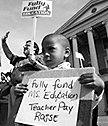Last week, the Mississippi Senate followed the lead of Gov. Haley Barbour in pushing for "home-rule" for the top-rated school districts in the state. The Senate voted 30-to-19 in favor of SB 2602, which supporters say would exempt schools from having to file needless paperwork with the state and allows the most freedom to the state's topmost rated schools, allowing those districts greater self-governance in regard to hiring and education practices for district employees.
"This is mostly dealing with what we call process standards, as opposed to curriculum-type standards, having to file certain paperwork with the state Department of Education," explained Rep. Cecil Brown, D-Jackson, who is chairman of the House Education Committee, and has paid nervous attention to the bill.
"Home-rule" cuts out much of the demands and state standards imposed upon higher-ranking schools. Current law dictates that schools must currently act under the lock and key of the state Board of Education, and that certain procedures proposed by the schools must be approved or exempted from state requirements.
Barbour has proposed that more school systems govern themselves, claiming the state will then be free to concentrate on problem districts. The issue really comes down to state money and how districts spend it, says Sen. Hob Bryan, D-Amory, who is on the Senate Education Committee. His description is in line with that of Barbour, who says schools should be allowed to spend money to their preference, so long as they remain within the realm of state law.
But they disagree on whether that is a good thing. Bryan complains that if exemptions can be held for higher rated schools, then the exemption should hold for all schools.
"If it's good enough for the higher level schools to use, then why not apply the same law to lower performing schools?" Ryan asked.
Susan Womack, executive director of Parents for Public Schools, said she didn't read the bill as being the end of institutional schooling in the state.
"I don't see it releasing schools from standardized tests or other state accountability measures," Womack said, predicting that there would be no return of corporal punishment to classrooms as a result of the bill. "Still, parents should pay close attention to how it's implemented," she said.
Bryan also had choice words for House Bill 215, which revamps the state's school funding formula, the Mississippi Adequate Education Program, which the state adopted in 1997 in order to equalize long-unfair funding of school districts around the state.
Bryan warned last year that "tweaking" the formula would inevitably mean "cutting funding," and said that tampering with it could bring problems. "MAEP works. I don't think we should be tampering with it when the state is already sorely underfunding its students," Bryan said.
The U.S. Census Bureau reported last year that New Jersey and New York each spent more than $12,000 per pupil, while Arizona and Mississippi spent less than half that, investing $6,000 per student. Utah ranked last in per-pupil spending at nearly $4,900. Mississippi routinely does not fully fund MAEP.
Brown said the new funding blueprint was "a good formula," but pointed out that it seemed to have no real effect on the bottom line of how much money is given out and said legislators needed to work harder on meeting the MAEP requirement.
"I think there's still some things that need doing," Brown said. "We need more money for so-called at-risk kids. We have a little bit of an increase that we give to districts with large numbers of kids that are free or reduced lunch kids and at-risk type kids, but it's not enough. All the research shows that it costs more to bring a kid up to standards who does not come from a print rich, or verbal-rich background." By "verbal-rich," Brown is referring to kids who are introduced to books at home or during after-school hours. "We need to do more than that," Brown added.
Last year state law established a commission to update the MAEP formula, with the intent of distribute state money equitably. The commission, formed with the blessing of Barbour, was intended to specifically deal with the issue of exploding enrollment in districts such as Desoto County and other districts, like Madison County, where student numbers are growing partially due to white flight to suburban areas.
The old formula calculates base student cost by randomly selecting districts, as opposed to pinpointing certain territories. Critics say the old formula also put a lag between the date the students are counted and the date the state allocates money, meaning a district losing students would get money for students who weren't there while schools in white-flight destination communities would not get proper financial accounting for new students.



Comments
Use the comment form below to begin a discussion about this content.